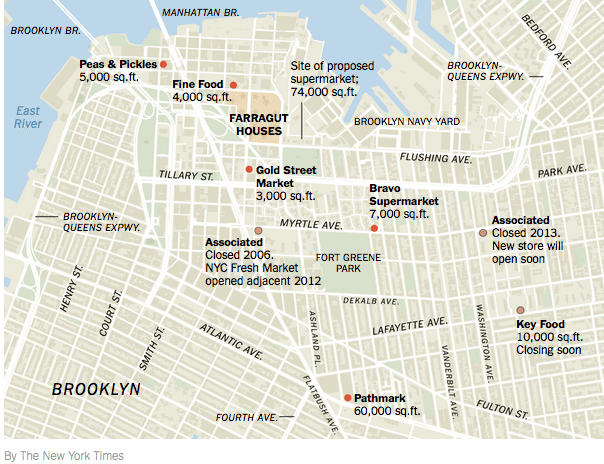Admiral’s Row Supermarket Delays Noted By New York Times

The long-delayed Admiral’s Row supermarket project and the ongoing food access issues that its absence brings into sharp relief were highlighted last week in a New York Times article that described the complex’s 3,500 residents of the area as having to travel between 1.5 and three-or-more miles to get to fresh food — a costly trek for those who can make the trip and a near impossible one for those who cannot due to age or disability.
Five years ago, the Bloomberg administration announced a plan to redevelop the dilapidated Admiral’s Row at the Brooklyn Navy Yard, and a supermarket was a central aspect of the proposal. But the first developer, PA Associates, was dropped after being charged in an unrelated bribery scandal; the second, Blumenfeld Development Group, claimed it was unable to find a supermarket willing to pay insurance premiums after Hurricane Sandy.
The crumbling homes of Admiral’s Row still stand today, even as the Brooklyn Navy Yard Development Corporation is considering, for the third time, proposals for a new developer. The winning bid will be announced by the end of June, the organization says. At the earliest, a 74,000-square-foot supermarket at the Admiral’s Row site will open in late 2017 — more than four years delayed.
The article tells how Karen Mann and Farragut Houses Tenants Association President Mary Andrews buy in bulk once or twice a month via cab and Access-A-Ride to Bed-Stuy, Atlantic Center, and Sunset Park, and struggle to get fresh produce in that timeline.
On average, a Farragut household has to live on $21,000 a year, and Ms. Andrews is not the only one of her neighbors to shop in Sunset Park. But a monthly trek to Costco is not practical for picking up perishables.
“The community really needs a place where they can purchase fresh fruits and vegetables,” she said.
For those living in the Farragut Houses, the closest option is the Fine Food Supermarket on York Street. At 4,000 square feet, it is about 5 percent the size of the proposed Admiral’s Row supermarket; sandwiched between the lone aisle of produce and the meat locker are various cat foods and religious candles.
Also noted is a paradox that residents have long noticed of existing supermarkets being replaced by residential developments — increasing demand while reducing supply.
Since 2006, two large, affordable supermarkets on Myrtle Avenue have closed, replaced by apartments; smaller and often more expensive specialty food stores have moved in to fill the void, although there are plans for a Key Food to open in one of the buildings.
The situation will soon become even more difficult. In February, Slate Property Group announced plans to close the Key Food at Lafayette Avenue and Grand Avenue in Clinton Hill. It, too, will be razed for residential development.
How and where do you get your groceries?




